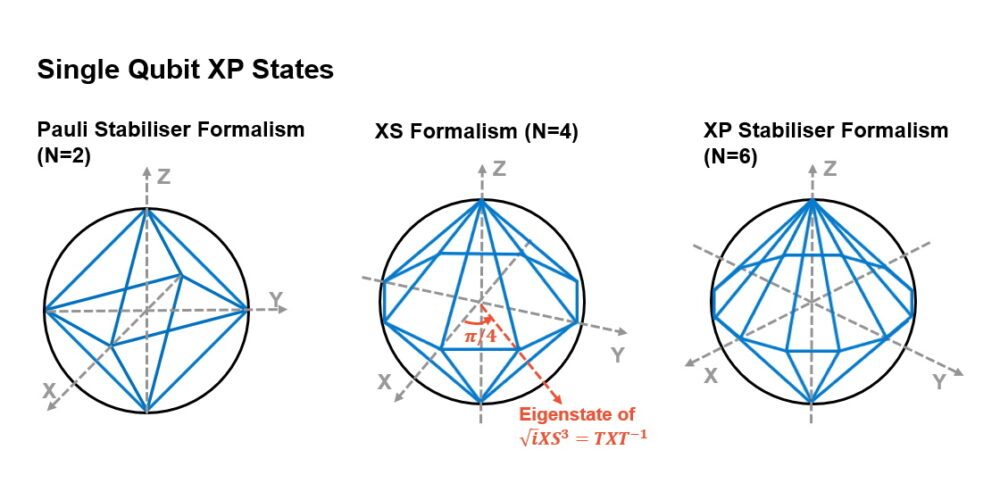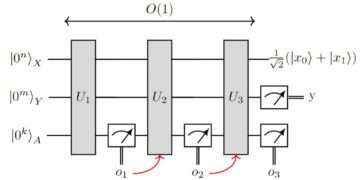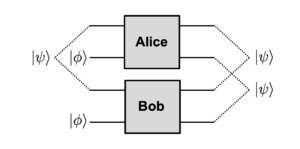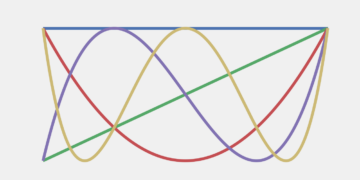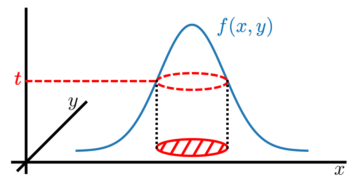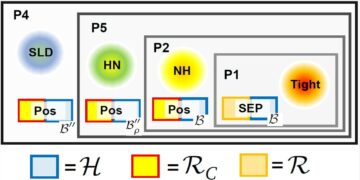1Centre for Engineered Quantum Systems, School of Physics, University of Sydney, Sydney, NSW 2006, Australia
2Sydney Quantum Academy, Sydney, NSW, Australia
3Niels Bohr International Academy, Niels Bohr Institute, Blegdamsvej 17, University of Copenhagen, 2100 Copenhagen, Denmark
Find this paper interesting or want to discuss? Scite or leave a comment on SciRate.
Abstract
We propose an extension to the Pauli stabiliser formalism that includes fractional $2pi/N$ rotations around the $Z$ axis for some integer $N$. The resulting generalised stabiliser formalism – denoted the XP stabiliser formalism – allows for a wider range of states and codespaces to be represented. We describe the states which arise in the formalism, and demonstrate an equivalence between XP stabiliser states and ‘weighted hypergraph states’ – a generalisation of both hypergraph and weighted graph states. Given an arbitrary set of XP operators, we present algorithms for determining the codespace and logical operators for an XP code. Finally, we consider whether measurements of XP operators on XP codes can be classically simulated.
Featured image: Example states on the qubit Bloch sphere for the Pauli stabiliser formalism, the XS formalism, and the XP stabiliser formalism ($N=6$ shown).
[embedded content]
Popular summary
In our work, we extend the Pauli stabiliser formalism by defining a $P$ operator which is a $1/N$ rotation around the Z axis. We allow stabiliser generators to be made from $X$ and $P$ operators. This allows us to describe a much wider range of states. We generalise many of the algorithms from the Pauli stabiliser formalism. Unlike the Pauli stabiliser formalism, operations on XP codes cannot always be classically simulated – for instance measurement of arbitrary XP operators on codespaces. The XP formalism allows us to identify a wider range of fault-tolerant logical operators on stabiliser codes – including transversal non-Clifford logical operators which are important in realising universal quantum computation.
► BibTeX data
► References
[1] Scott Aaronson and Daniel Gottesman. Improved simulation of stabilizer circuits. Phys. Rev. A, 70: 052328, Nov 2004. 10.1103/PhysRevA.70.052328.
https://doi.org/10.1103/PhysRevA.70.052328
[2] Juan Bermejo-Vega and Maarten Van Den Nest. Classical simulations of abelian-group normalizer circuits with intermediate measurements. Quantum Info. Comput., 14 (3–4): 181–216, Mar 2014. ISSN 1533-7146. 10.26421/QIC14.3-4-1.
https://doi.org/10.26421/QIC14.3-4-1
[3] Juergen Bierbrauer. Introduction to coding theory. Discrete mathematics and its applications. Taylor and Francis, Boca Raton, second edition, Sep 2016. ISBN 9781315371993. 10.1201/9781315371993.
https://doi.org/10.1201/9781315371993
[4] Benjamin J. Brown, Daniel Loss, Jiannis K. Pachos, Chris N. Self, and James R. Wootton. Quantum memories at finite temperature. Rev. Mod. Phys., 88: 045005, Nov 2016. 10.1103/RevModPhys.88.045005.
https://doi.org/10.1103/RevModPhys.88.045005
[5] Johannes Buchmann and Stefan Neis. Algorithms for linear algebra problems over principal ideal rings. Technical Report TI-7/96, TU Darmstadt, Jan 1996. URL http://tubiblio.ulb.tu-darmstadt.de/101111/.
http://tubiblio.ulb.tu-darmstadt.de/101111/
[6] Earl T. Campbell. The smallest interesting colour code. Blog Post, Sep 2016. URL https://earltcampbell.com/2016/09/26/the-smallest-interesting-colour-code/.
https://earltcampbell.com/2016/09/26/the-smallest-interesting-colour-code/
[7] Andrew Cross, Graeme Smith, John A. Smolin, and Bei Zeng. Codeword stabilized quantum codes. IEEE Transactions on Information Theory, 55 (1): 433–438, Aug 2009. 10.1109/TIT.2008.2008136.
https://doi.org/10.1109/TIT.2008.2008136
[8] Julio Carlos Magdalena de la Fuente, Nicolas Tarantino, and Jens Eisert. Non-Pauli topological stabilizer codes from twisted quantum doubles. Quantum, 5: 398, Feb 2021. 10.22331/q-2021-02-17-398.
https://doi.org/10.22331/q-2021-02-17-398
[9] David Elieser Deutsch. Quantum computational networks. Proceedings of the Royal Society of London. Series A, Mathematical and physical sciences, 425 (1868): 73–90, Sep 1989. ISSN 1364-5021. 10.1098/rspa.1989.0099.
https://doi.org/10.1098/rspa.1989.0099
[10] Tyler D. Ellison, Yu-An Chen, Arpit Dua, Wilbur E. Shirley, Nathanan Tantivasadakarn, and Dominic J. Williamson. Pauli stabilizer models of twisted quantum doubles. arXiv:2112.11394 [quant-ph], Dec 2021. 10.48550/arXiv.2112.11394.
https://doi.org/10.48550/arXiv.2112.11394
arXiv:2112.11394
[11] Vlad Gheorghiu. Standard form of qudit stabilizer groups. Physics Letters A, 378 (5): 505–509, Jan 2014. ISSN 0375-9601. 10.1016/j.physleta.2013.12.009.
https://doi.org/10.1016/j.physleta.2013.12.009
[12] D Gottesman. The Heisenberg representation of quantum computers. arXiv:quant-ph/9807006, Jun 1998.
arXiv:quant-ph/9807006
[13] D. Gross, J. Eisert, N. Schuch, and D. Perez-Garcia. Measurement-based quantum computation beyond the one-way model. Phys. Rev. A, 76: 052315, Nov 2007. 10.1103/PhysRevA.76.052315.
https://doi.org/10.1103/PhysRevA.76.052315
[14] L Hartmann, J Calsamiglia, W Dür, and H J Briegel. Weighted graph states and applications to spin chains, lattices and gases. Journal of Physics B: Atomic, Molecular and Optical Physics, 40 (9): S1–S44, Apr 2007. 10.1088/0953-4075/40/9/s01.
https://doi.org/10.1088/0953-4075/40/9/s01
[15] John A. Howell. Spans in the module $(mathbb{Z}_m)^s$. Linear and Multilinear Algebra, 19 (1): 67–77, Jan 1986. 10.1080/03081088608817705.
https://doi.org/10.1080/03081088608817705
[16] A.Yu Kitaev. Fault-tolerant quantum computation by anyons. Annals of physics, 303 (1): 2–30, Jan 2003. ISSN 0003-4916. 10.1016/S0003-4916(02)00018-0.
https://doi.org/10.1016/S0003-4916(02)00018-0
[17] Jacob Miller and Akimasa Miyake. Hierarchy of universal entanglement in 2D measurement-based quantum computation. npj Quantum Information, 2: 16036, Nov 2016. 10.1038/npjqi.2016.36.
https://doi.org/10.1038/npjqi.2016.36
[18] Xiaotong Ni, Oliver Buerschaper, and Maarten Van den Nest. A non-commuting stabilizer formalism. Journal of Mathematical Physics, 56 (5): 052201, May 2015. 10.1063/1.4920923.
https://doi.org/10.1063/1.4920923
[19] Michael A. Nielsen and Isaac L. Chuang. Quantum Computation and Quantum Information: 10th Anniversary Edition. Cambridge University Press, Dec 2010. 10.1017/CBO9780511976667.
https://doi.org/10.1017/CBO9780511976667
[20] Román Orús. A practical introduction to tensor networks: Matrix product states and projected entangled pair states. Annals of Physics, 349: 117–158, Oct 2014. ISSN 0003-4916. 10.1016/j.aop.2014.06.013.
https://doi.org/10.1016/j.aop.2014.06.013
[21] Eric M. Rains, R. H. Hardin, Peter W. Shor, and N. J. A. Sloane. A nonadditive quantum code. Phys. Rev. Lett., 79: 953–954, Aug 1997. 10.1103/PhysRevLett.79.953.
https://doi.org/10.1103/PhysRevLett.79.953
[22] Narayanan Rengaswamy, Robert Calderbank, Michael Newman, and Henry D. Pfister. On optimality of CSS codes for transversal T. IEEE Journal on Selected Areas in Information Theory, 1 (2): 499–514, Aug 2020. 10.1109/JSAIT.2020.3012914.
https://doi.org/10.1109/JSAIT.2020.3012914
[23] M Rossi, M Huber, D Bruß, and C Macchiavello. Quantum hypergraph states. New Journal of Physics, 15 (11): 113022, Nov 2013. 10.1088/1367-2630/15/11/113022.
https://doi.org/10.1088/1367-2630/15/11/113022
[24] Ady Stern. Anyons and the quantum Hall effect—a pedagogical review. Annals of Physics, 323 (1): 204–249, Jan 2008. ISSN 0003-4916. 10.1016/j.aop.2007.10.008.
https://doi.org/10.1016/j.aop.2007.10.008
[25] Arne Storjohann. Algorithms for Matrix Canonical Forms. PhD thesis, Department of Computer Science, Swiss Federal Institute of Technology – ETH, 2000. URL https://cs.uwaterloo.ca/ astorjoh/diss2up.pdf.
https://cs.uwaterloo.ca/~astorjoh/diss2up.pdf
[26] Maarten Van den Nest, Jeroen Dehaene, and Bart De Moor. Graphical description of the action of local Clifford transformations on graph states. Phys. Rev. A, 69: 022316, Feb 2004. 10.1103/PhysRevA.69.022316.
https://doi.org/10.1103/PhysRevA.69.022316
Cited by
Could not fetch Crossref cited-by data during last attempt 2022-09-22 15:18:33: Could not fetch cited-by data for 10.22331/q-2022-09-22-815 from Crossref. This is normal if the DOI was registered recently. On SAO/NASA ADS no data on citing works was found (last attempt 2022-09-22 15:18:34).
This Paper is published in Quantum under the Creative Commons Attribution 4.0 International (CC BY 4.0) license. Copyright remains with the original copyright holders such as the authors or their institutions.

